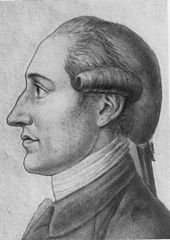Barbara Schulthess

Barbara Schulthess , b. Wolf (born October 5, 1745 in Zurich ; † April 12, 1818 there ) was a friend of Johann Wolfgang von Goethe and Johann Caspar Lavater . Schulthess was called Babe by contemporaries . It was considered to be the center of beautiful Zurich in the late 18th century.
Life
Schulthess was born as the daughter of a wealthy silk manufacturer in Zurich. In 1763 she married the silk manufacturer and captain David Schulthess, with whom she had four children. David Schulthess died in 1778, so that Barbara raised the children alone.
In 1772 the couple bought the Schönhof in the Zurich suburbs. In the following years it developed into a contact point for Zurich society. It was primarily through her friend Johann Caspar Lavater that Schulthess came into contact with almost all of Zurich's great intellectuals and scholars who were visiting Zurich. Concerts were often held and the house also served as a studio for painters. Schulthess was also a mediator of literature, had her transcripts of current works circulate and organized as Salonnière evenings in which the latest publications on the Swiss book market were read to oneself and also composed.
Schulthess' children died young. Around 1800 only the youngest daughter lived, with whose family she lived in her birthplace, the so-called "Neuhaus", Oberdorfstrasse 5, until her death in 1818. The Schönhof was demolished in 1935.
Barbara Schulthess and Johann Wolfgang von Goethe

Johann Wolfgang von Goethe met Schulthess on his first trip to Switzerland in 1775. Johann Caspar Lavater had made the acquaintance. Goethe and Philipp Christoph Kayser worked as piano teachers for their children in the Schönenhof.
In the following years, a lively correspondence developed between Johann Wolfgang von Goethe and Schulthess. In 1779 he visited the meanwhile widowed Babe again on his second trip to Switzerland. Here, among other things, the poem Gesang der Geister über den Wasser was written , which Goethe dedicated to his girlfriend and whose original manuscript was found in her estate in 1902. Both met again in Constance in 1788, but the friendship slowly cooled in the next few years, which was also due to Goethe's increasingly critical attitude towards Schulthess' long-time friend Lavater. Goethe paid her one last visit in 1797 in Zurich.
Schulthess burned the correspondence with Goethe shortly before her death and Goethe also destroyed the letters his girlfriend had written until 1792.
Literary historical significance
From 1779, Goethe sent Schulthess numerous manuscripts of his latest works, such as For example, the designs by Iphigenie auf Tauris , Torquato Tasso or Hermann and Dorothea , which Schulthess copied together with her eldest daughter Anna Barbara and also read out in the conviviality of the Schönenhof. In 1909, Schulthess' great-great-grandson Gustav Billeter found books I – VI of the original version of Wilhelm Meister which Goethe had destroyed . It was a copy of the original by Schulthess and her eldest daughter and is considered the only surviving version of the original master . It first appeared in 1911 under the title Wilhelm Meister's theatrical broadcast at Cotta in Stuttgart.
literature
- Bernhard Suphan : Goethe and Barbara Schulthess . Rütten & Loening, Frankfurt 1892.
- Gustav von Schulthess-Rechberg: Mrs. Barbara Schulthess to the Schönenhof, the friend Lavater and Göthes . Report house, Zurich 1903.
- Hans Trog : Frau (Babe) Barbara Schulthess, Goethe and his Wilhelm Meister . In: Schweizer Illustrierte , Vol. 14, 1910, pp. 165–168.
- Friedrich Zollinger: Goethe in Zurich . Atlantis, Zurich 1932.
- Ute Kröger: "Zurich, you my blue miracle". Literary forays through a European city of culture . Limmat, Zurich 2004 ISBN 3-85791-447-5 .
- Johann Georg Schulthess : wedding speech to Mr. Georg Gessner , and virgin Barbara Schulthess, held on May 23, 1791 in Kloten near Zurich. Zurich 1791.
Web links
- Christian Moser: Schulthess, Barbara. In: Historical Lexicon of Switzerland .
- [1] Letters to Goethe
- Lecture 2007 by Hans Georg Schulthess, Zurich, about different branches of this family; with references to the family over several centuries
Individual evidence
- ↑ in the holdings of the Zurich Central Library. Both families were among the leading patricians in the city. For the connection between the two Schulthess' (bride, pastor) see web link: Lecture 2007. Gessner belonged to the families around the publisher later called Orell Füssli .
| personal data | |
|---|---|
| SURNAME | Schulthess, Barbara |
| ALTERNATIVE NAMES | Wolf, Barbara; Schulthess, Babes |
| BRIEF DESCRIPTION | Swiss salonnière and pen pal Johann Wolfgang von Goethes |
| DATE OF BIRTH | October 5, 1745 |
| PLACE OF BIRTH | Zurich , Switzerland |
| DATE OF DEATH | April 12, 1818 |
| Place of death | Zurich , Switzerland |
